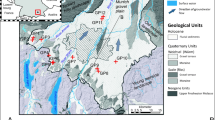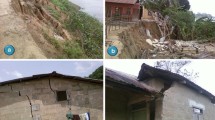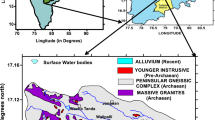Abstract
The hydrogeologic and hydraulic characteristics of a lateritic terrain in West Bengal, India, were investigated. Test drilling was conducted at ten sites and grain-size distribution curves (GSDCs) were prepared for 275 geologic samples. Performance evaluation of eight grain-size-analysis (GSA) methods was carried out to estimate the hydraulic conductivity (K) of subsurface formations. Finally, the GSA results were validated against pumping-test data. The GSDCs indicated that shallow aquifer layers are coarser than the deeper aquifer layers (uniformity coefficient 0.19–11.4). Stratigraphy analysis revealed that both shallow and deep aquifers of varying thickness exist at depths 9–40 and 40–79 m, respectively. The mean K estimates by the GSA methods are 3.62–292.86 m/day for shallow aquifer layers and 0.97–209.93 m/day for the deeper aquifer layers, suggesting significant aquifer heterogeneity. Pumping-test data indicated that the deeper aquifers are leaky confined with transmissivity 122.69–693.79 m2/day, storage coefficient 1.01 × 10−7–2.13 × 10−4 and leakance 2.01 × 10−7–34.56 × 10−2 day−1. Although the K values yielded by the GSA methods are generally larger than those obtained from the pumping tests, the Slichter, Harleman and US Bureau Reclamation (USBR) GSA methods yielded reasonable values at most of the sites (1–3 times higher than K estimates by the pumping-test method). In conclusion, more reliable aquifers exist at deeper depths that can be tapped for dependable water supply. GSA methods such as Slichter, Harleman and USBR can be used for the preliminary assessment of K in lateritic terrains in the absence of reliable field methods.
Résumé
Les caractéristiques hydrogéologiques et hydrauliques des terrains latéritiques du Bengale occidental, Inde, ont été étudiées. Des forages ont été réalisés sur dix sites et les courbes de distribution granulométrique (GSDCs) ont été préparées pour 275 échantillons géologiques. L’évaluation de la performance de huit méthodes d’analyses granulométriques (GSA) a été réalisée afin d’estimer la conductivité hydraulique (K) des formations de sub-surface. Enfin, les résultats de GSA ont été validées à l’aide des données d’essais de pompage. Les GSDCs indiquent que les formations de l’aquifère peu profond sont plus grossières que les formations de l’aquifère plus profond (coefficient d’uniformité 0.19–11 .4). L’analyze stratigraphique indique que les aquifères peu profonds ainsi que les aquifères profonds d’une épaisseur variable sont présents à des profondeurs de 9–40 et 40–79 m, respectivement. Les estimations du K moyen à partir des méthodes de GSA sont de 3.62–292.86 m/jour pour les formations de l’aquifère peu profond et de 0.97–209.93 m/jour pour les formations de l’aquifère plus profond, suggérant une hétérogénéité d’aquifère significative. Les données des essais de pompage indiquent que les aquifères plus profonds sont captifs drainants avec une transmissivité de 122.69–693.79 m2/jour, un coefficient d’emmagasinement de 1.01 × 10−7–2.13 × 10−4 et une drainance de 2.01 × 10−7–34.56 × 10−2 jour−1. Bien que les valeurs de K obtenues par les méthodes GSA soient généralement plus grandes que celles obtenues par les essais de pompages, les méthodes GSA de Slichter, Harleman et du US Reclamation Bureau (USBR) fournissent des valeurs raisonnables pour la plupart des sites (1–3 fois plus élevée que pour les estimations de K par la méthode des essais de pompage). En conclusion, des aquifères plus fiables existent à des profondeurs plus importantes et peuvent être exploités de manière sûre pour l’approvisionnement en eau. Les méthodes GSA telles que celles de Slichter, Harelman et USBR peuvent être utilisées pour une évaluation préliminaire de K dans des terraines latéritiques en absence de méthodes de terrain fiables.
Resumen
Se investigaron las características hidrogeológicas e hidráulicas de un terreno laterítico en Bengala Occidental, India. Se realizaron ensayos de perforaciones en diez sitios y se prepararon curvas de distribución del tamaño de grano (GSDC) para 275 muestras geológicas. La evaluación del rendimiento de ocho métodos de análisis de tamaño de grano (GSA) se llevó a cabo para estimar la conductividad hidráulica (K) de las formaciones del subsuelo. Finalmente, los resultados de los GSA se validaron contra datos de ensayos de bombeo. Los GSDC indicaron que las capas de acuíferas someras son más gruesas que las capas más profundas del acuífero (coeficiente de uniformidad 0.19–11.4). El análisis de la estratigrafía reveló que existen acuíferos someros y profundos de espesor variable a profundidades de 9–40 y 40–79 m, respectivamente. Las estimaciones de K medias por los métodos GSA son 3.62–292.86 m/día para las capas de acuíferos someros y 0.97–209.93 m/día para las capas más profundas del acuífero, lo que sugiere una heterogeneidad significativa del acuífero. Los datos de los ensayos de bombeo indicaron que los acuíferos más profundos tienen una filtración confinante con una transmisividad de 122.69–693.79 m2/día, un coeficiente de almacenamiento 1.01 × 10−7–2.13 × 10−4 y una filtración vertical 2.01 × 10−7–34.56 × 10−2 día−1. Aunque los valores de K obtenidos por los métodos de GSA son generalmente más grandes que los logrados con los ensayos de bombeo, los métodos GSA de Slichter, Harleman y US Bureau Reclamation (USBR) arrojaron valores razonables en la mayoría de los sitios (1–3 veces mayor que las estimaciones K por el método de ensayos de bombeo). En conclusión, existen acuíferos más confiables a profundidades más profundas que pueden aprovecharse para un suministro seguro de agua. Los métodos de GSA como Slichter, Harleman y USBR pueden usarse para la evaluación preliminar de K en terrenos lateríticos en ausencia de métodos de campo confiables.
摘要
研究了印度西孟加拉邦红土地貌的水文地质和水力学特征。在10个地点进行测试钻探,并为275个地质样品制备粒度分布曲线(GSDCs)。对八种粒度分析(GSA)方法进行了性能评估,以评估地下地层的渗透系数(K)。最后,GSA结果通过抽水试验数据进行验证。 GSDCs表明浅层含水层比较深的含水层粗(均匀系数0.19–11.4)。地层分析表明,不同厚度的浅层和深层含水层分别存在于9–40 m和40–79 m的深度。 GSA方法估算的平均K值为浅层含水层3.62–292.86 m /天,深层含水层为0.97–209.93 m /天,表明含水层非均质性明显。抽水试验结果表明,深层含水层渗透率为122.69–693.79 m2 / d,储水系数为1.01 × 10−7–2.13 × 10−4,渗漏率为2.01 × 10−7–34.56 × 10−2 day−1 。尽管GSA方法产生的K值通常大于抽水试验所得到的K值,但Slichter,Harleman和US Bureau Reclamation(USBR)GSA方法在大多数地点产生了合理的值(比K估计值高1到3倍通过抽水试验方法)。总而言之,在更深的水深处存在更可靠的含水层,可用于可靠的供水。如Slichter,Harleman和USBR等GSA方法可用于在没有可靠现场方法的情况下对红土地区的钾进行初步评估。
Resumo
As características hidrogeológicas e hidráulicas de um terreno laterítico em Bengala Ocidental, na Índia, foram investigadas. Teste em perfuração foi realizado em dez locais e as curvas de distribuição de tamanho de grão (CDTGs) foram preparadas para 275 amostras geológicas. A avaliação de desempenho de oito métodos de análise de tamanho de grão (ATG) foi realizada para estimar a condutividade hidráulica (K) das formações subterrâneas. Finalmente, os resultados da ATG foram validados em comparação aos dados de teste de bombeamento. As CDTGs indicaram que as camadas aquíferas rasas são mais grossas do que as camadas aquíferas profundas (coeficiente de uniformidade 0.19–11.4). Análises estratigráficas revelaram que ambos aquíferos, raso e profundo, de espessura variável, existem a profundidades de 9–40 e 40–79 m, respectivamente. As estimativas médias de K pelos métodos de ATG são 3.62–292.86 m/dia para camadas aquíferas rasas e 0.97–209.93 m/dia para as camadas aquíferas profundas, sugerindo significativa heterogeneidade do aquífero. Dados de teste de bombeamento indicaram que os aquíferos profundos estão pouco confinados com transmissividade 122.69–693.79 m2/dia, coeficiente de armazenamento 1.01 × 10−7–2.13 × 10−4 e drenança 2.01 × 10−7–34.56 × 10−2 dia−1. Embora os valores de K obtidos pelos métodos ATG sejam geralmente superiores aos obtidos com os testes de bombeamento, os métodos ATG da Slichter, Harleman e US Bureau Reclamation (USBR) renderam valores razoáveis na maioria dos locais (1–3 vezes superiores às estimativas de K pelo método de teste de bombeamento). Em conclusão, os melhores aquíferos estão em maiores profundidades e podem ser aproveitados para o abastecimento de água. Os métodos ATG, tais como Slichter, Harleman e USBR, podem ser utilizados em uma avaliação preliminar de K em terrenos lateríticos na ausência de métodos de campo confiáveis.













Similar content being viewed by others
References
Alyamani MS, Şen Z (1993) Determination of hydraulic conductivity from complete grain-size distribution curves. Groundwater 31(4):551–555
Arnold TL, Friedel MJ, Warner KL (2001) Hydrogeologic inventory of the upper Illinois River basin creating a large data base from well construction records. Geol Models Groundwater Flow Model. Illinois State Geol Surv Open File Ser 2001:1–5
Barr DW (2001) Coefficient of permeability by measurable parameters. Groundwater 39(3):356–361
Beyer W (1964) On the determination of hydraulic conductivity of gravels and sands from grain-size distributions. Wasserwirtschaft-Wassertechnik 14(6):165–169
Bouwer H (1978) Groundwater hydrology. McGraw-Hil, New York
Carrier WD (2003) Goodbye, Hazen; hello, Kozeny-Carman. J Geotech Geoenviron 129(11):1054–1056
CGWB (2008) Paschim Medinipur at a glance. Central Ground Water Board, New Delhi. http://www.cgwb.gov.in/District_Profile/WestBangal/Paschim%20Medinipur.pdf. Accessed 20 October 2017
CGWB (2013) Groundwater year book. Central Ground Water Board, New Delhi, India; Ministry of Water Resources, Faridabad, India, 91 pp
Chapuis RP (2004) Predicting the saturated hydraulic conductivity of sand and gravel using effective diameter and void ratio. Can Geotech J 41(5):787–795
Cheng C, Chen XH (2007) Evaluation of methods for determination of hydraulic properties in an aquifer–aquitard system hydrologically connected to a river. Hydrogeol J 15(4):669–678
Cheong J-Y, Hamm S-Y, Kim H-S, Ko E-J, Yang K, Lee J-H (2008) Estimating hydraulic conductivity using grain-size analyses, aquifer test, and numerical modeling in a riverside alluvial system in South Korea. Hydrogeol J 16(6):1129–1143
Cronican AE, Gribb MM (2004) Hydraulic conductivity prediction for sandy soils. Groundwater 42(3):459–464
Devlin JF (2015) HydrogeosieveXL: an excel-based tool to estimate hydraulic from grain-size analysis. Hydrogeol J 23:837–844
Elwaseif M, Ismail A, Abdalla M, Abdel-Rahman M, Hafez MA (2012) Geophysical and hydrological investigations at the West Bank of Nile River (Luxor, Egypt). Environ Earth Sci 67(3):911–921
Fetter CW (2000) Applied hydrogeology, 4th edn. Prentice Hall, Upper Saddle River, NJ
Freeze RA, Cherry JA (1979) Groundwater. Prentice-Hal, Upper Saddle River, NJ
Garg KK, Jha MK, Kar S (2005) Field investigation of water movement and nitrate transport under perched water table conditions. Biosyst Eng 92(1):69–84
Garg SK (2011) Irrigation engineering and hydraulic structures. Khanna, New Delhi
Hantush MS, Jacob CE (1955) Non-steady radial flow in an infinite leaky aquifer. Trans Am Geophys Union 36(1):95–100
Harleman DRF, Mehlhorn PF, Rumer RR (1963) Dispersion-permeability correlation in porous media. J Hydraul Div 89(2):67–85
Hazen A (1892) Some physical properties of sands and gravels with special reference to their use in filtration. 24th annual report, Massachusetts State Board of Health, Boston, pp 539–556
Hwang SI, Powers SE (2003) Using particle-size distribution models to estimate soil hydraulic properties. Soil Sci Soc Am J 67(4):1103–1112
Ishaku JM, Gadzama EW, Kaigama U (2011) Evaluation of empirical formulae for the determination of hydraulic conductivity based on grain-size analysis. J Geol Mining Res 3(4):105–113
Jha MK, Singh A (2014) Application of genetic algorithm technique to inverse modeling of tide–aquifer interaction. Environ Earth Sci 71(8):3655–3672
Jha MK, Jayalekshmi K, Machiwal D, Kamii Y, Chikamori K (2004) Determination of hydraulic parameters of an unconfined alluvial aquifer by the floodwave-response technique. Hydrogeol J 12(6):628–642
Jha MK, Namgial D, Kamii Y, Peiffer S (2008) Hydraulic parameters of coastal aquifer systems by direct methods and an extended tide–aquifer interaction technique. Water Resour Manag 22(12):1899–1923
Li P, Qian H, Wu J (2014) Comparison of three methods of hydrogeological parameter estimation in leaky aquifers using transient flow pumping tests. Hydrol Process 28(4):2293–2301
Li P, Qian H (2013) Global curve-fitting for determining the hydrogeological parameters of leaky confined aquifers by transient flow pumping test. Arab J Geosci 6(8):2745–2753
London MK, Rus DL, Harvey FE (2001) Comparison of instream methods for measuring hydraulic conductivity in sandy stream beds. Groundwater 39(6):870–885
Lu C, Chen X, Cheng C, Ou G, Shu L (2012) Horizontal hydraulic conductivity of shallow streambed sediments and comparison with the grain-size analysis results. Hydrol Process 26(3):454–466
Machiwal D, Jha MK (2016) Exploring hydrology and groundwater dynamics in lateritic terrain of West Bengal, India, under data limited conditions. Environ Earth Sci 75(9):1–19
Machiwal D, Singh PK, Yadav KK (2017) Estimating aquifer properties and distributed groundwater recharge in a hard-rock catchment of Udaipur, India. Appl Water Sci 7(6):3157–3172
Maclear LGA (2001) The hydrogeology of the Uitenhage Artesian Basin with reference to the Table Mountain Group Aquifer. Water SA 27(4):499–506
Odong J (2007) Evaluation of empirical formulae for determination of hydraulic conductivity based on grain-size analysis. J Am Sci 3(3):54–60
Pliakas F, Petalas C (2011) Determination of hydraulic conductivity of unconsolidated river alluvium from permeameter tests, empirical formulas and statistical parameters effect analysis. Water Resour Manag 25(11):2877–2899
Raghunath HM (2007) Ground water. New Age, New Delhi
Reynolds RJ (1987) Diffusivity of a glacial outwash aquifer by the floodwave-response technique. Ground Water 25(3):290–299
Rodell M, Velicogna I, Famiglietti JS (2009) Satellite-based estimates of groundwater depletion in India. Nature 460(7258):999–1002
Rosas J, Lopez O, Missimer TM, Coulibaly KM, Dehwah AHA, Sesler K, Lujan LR, Mantilla D (2014) Determination of hydraulic conductivity from grain-size distribution for different depositional environments. Groundwater 52(3):399–413
Rosas J, Jadoon KZ, Missimer TM (2015) New empirical relationship between grain-size distribution and hydraulic conductivity for ephemeral streambed sediments. Environ Earth Sci 73(3):1303–1315
Roscoe Moss Co. (1990) Handbook of ground water development. Wiley, New York
Samuel MP, Jha MK (2003) Estimation of aquifer parameters from pumping test data by genetic algorithm optimization technique. J Irrigation Drain Eng ASCE 129(5):348–359
Schwartz FW, Zhang H (2003) Fundamentals of ground water. JWiley, New York
Slichter CS (1898) A theoretical investigation of the motion of ground waters. 19th. Annual report, US Geological Survey, Reston, VA, pp 295–384
Song J, Chen X, Wang D, Lackey S, Xu Z (2009) Feasibility of grain-size analysis methods for determination of vertical hydraulic conductivity of streambeds. J Hydrol 375(3):428–437
Soupios PM, Kalisperi D, Kanta A, Kouli M, Barsukov P, Vallianatos F (2010) Coastal aquifer assessment based on geological and geophysical survey, northwestern Crete, Greece. Environ Earth Sci 61(1):63–77
Todd DK (1980) Groundwater hydrology. Wiley, New York
Vienken T, Dietrich P (2011) Field evaluation of methods for determining hydraulic conductivity from grain size data. J Hydrol 400(1):58–71
Vukovic M, Soro A (1992) Determination of hydraulic conductivity of porous medium from grain-size composition. Water Resources Publications, Littleton, CO
WHI (2002) AquiferTest V 3.5 User’s Manual 2002. Waterloo Hydrogeologic, Waterloo, ON
World Bank Group (ed) (2012) World development indicators 2012. World Bank, Washington, DC
WWAP (2015) The United Nations world water development report 2015: water for a sustainable world. United Nations World Water Assessment Programme (WWAP), Paris, 139 pp
Wyrwoll P (2012) India’s groundwater crisis. Global Water Forum, Canberra, Australia. http://www.globalwaterforum.org/2012/07/30/indias-groundwater-crisis. Accessed January 31, 2017
Acknowledgements
We are thankful to Prof. J. F. Devlin for his technical discussion related to GSA methods. Sincere thanks are also due to the associate editor and two anonymous reviewers for their meticulous and constructive comments/suggestions that improved the manuscript considerably.
Funding
We are grateful to the Ministry of Human Resource Development, Government of India, New Delhi, for providing financial support in terms of the research project and scholarship to carry out this research work. The financial support provided by the Indian Council of Agricultural Research (ICAR), New Delhi, is also gratefully acknowledged.
Author information
Authors and Affiliations
Corresponding author
Rights and permissions
About this article
Cite this article
Biswal, S., Jha, M.K. & Sharma, S.P. Hydrogeologic and hydraulic characterization of aquifer and nonaquifer layers in a lateritic terrain (West Bengal, India). Hydrogeol J 26, 1947–1973 (2018). https://doi.org/10.1007/s10040-018-1722-5
Received:
Accepted:
Published:
Issue Date:
DOI: https://doi.org/10.1007/s10040-018-1722-5




